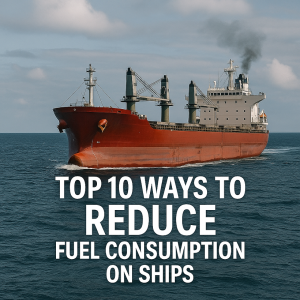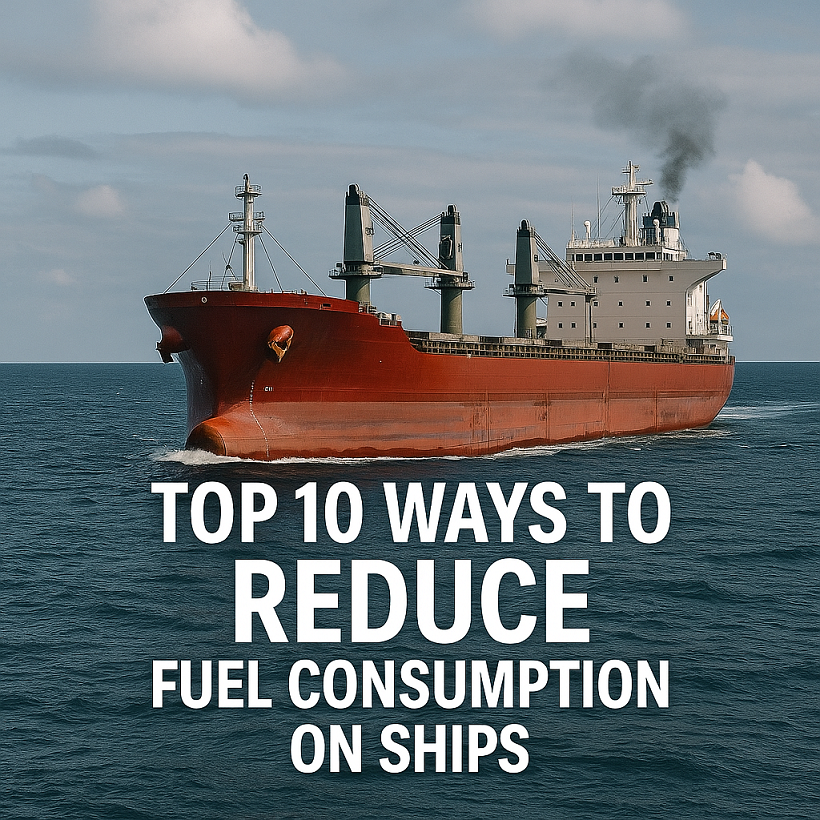
Discover the top 10 proven ways to reduce fuel consumption on ships. Learn about smart operations, modern technologies, and real-world case studies helping the maritime industry save costs and cut emissions.
Why Fuel Efficiency at Sea Matters
If you step onto the bridge of a modern merchant ship today, you’ll notice a constant tension between two imperatives: carrying global trade safely and cutting operating costs. Fuel sits at the heart of both.
Marine fuel—or “bunkers” as seafarers call it—accounts for 40–60% of a ship’s operating expenses (ICS, 2024). At the same time, it is the single largest contributor to shipping’s greenhouse gas emissions, which represent about 2–3% of global CO₂ emissions according to the IMO’s Fourth GHG Study (2020). Reducing fuel consumption is therefore not just about saving money; it’s about meeting climate targets, ensuring compliance with MARPOL Annex VI emission limits, and keeping shipping competitive in an increasingly sustainability-driven world.
But fuel efficiency is not new to shipping. Even a century ago, steamship owners carefully trimmed their coal bunkers and adjusted engine speeds to maximize endurance at sea. What’s different today is the scale: giant container ships, LNG carriers, and cruise liners consume thousands of tonnes of fuel every voyage. Small changes in operations or design can mean millions in annual savings and significant environmental benefits.
This guide explores the top 10 ways ships can reduce fuel consumption, from tried-and-tested operational measures like slow steaming to futuristic technologies such as air lubrication systems. Each section blends technical clarity, real-world applications, and practical insights for students, maritime professionals, and anyone curious about the industry.
Why Reducing Ship Fuel Consumption Matters
Before diving into the top 10 strategies, it’s worth understanding the stakes.
- Economic pressure: Fuel is volatile. In 2022, marine fuel prices surged above USD 1,000/tonne in some ports due to geopolitical tensions. Ship operators must hedge against unpredictable costs.
- Environmental obligations: Regulations under IMO 2020 Sulphur Cap and EEXI/CII (Energy Efficiency Existing Ship Index & Carbon Intensity Indicator) push operators to cut emissions through efficiency.
- Charterer expectations: Major cargo owners—from IKEA to Amazon—now require green credentials in shipping partners, creating competitive pressure.
- Public image: Accidents aside, nothing harms a shipping line’s brand like being tagged “polluting.” Efficiency projects support ESG strategies and corporate reputation.
In other words, reducing fuel use is a win-win: it saves money, helps meet international law, and aligns with global decarbonization goals.
–
Top 10 Ways to Reduce Fuel Consumption on Ships
1. Slow Steaming: Sailing Smarter, Not Faster
Slow steaming—reducing vessel speed below design speed—has been one of the most impactful fuel-saving strategies.
-
How it works: Fuel consumption is not linear with speed. A 10% reduction in speed can cut fuel use by up to 27%, according to DNV.
-
Real-world example: Maersk Line pioneered large-scale slow steaming after the 2008 financial crisis, reducing CO₂ emissions by millions of tonnes annually.
-
Challenges: It requires coordination with charterers and supply chains. Delays at ports may offset savings if logistics aren’t aligned.
Still, in today’s decarbonization era, slow steaming remains a backbone of fuel-saving operations.
2. Hull Cleaning and Propeller Polishing
A clean hull moves like a fish through water. A fouled hull drags like a rusty anchor.
-
Biofouling impact: Even a thin layer of slime can increase fuel consumption by up to 20% (IMO GloFouling Project, 2021).
-
Solutions: Regular underwater hull cleaning, advanced antifouling paints, and propeller polishing restore hydrodynamic efficiency.
-
Case study: The US Navy reported savings of $180 million per year by adopting proactive hull cleaning programs (Naval Research Lab, 2019).
Modern coatings, such as silicone-based foul-release systems, extend drydock intervals and keep hulls smooth longer.
3. Voyage Optimization: Data Meets Navigation
Navigation has come a long way from sextants and stars. Today, ships use AI-driven systems to plan the most fuel-efficient routes.
-
Weather routing: Avoiding storms, high waves, and strong currents can save 3–7% fuel per voyage (Inmarsat, 2023).
-
Digital twins: Companies like Wärtsilä and StormGeo provide real-time voyage optimization based on ship performance and oceanographic data.
-
Example: A tanker using voyage optimization software on a transatlantic crossing saved 200 tonnes of fuel compared to a traditional route.
Voyage optimization combines seamanship with data science—a key skill for modern deck officers.
4. Engine Performance Monitoring and Maintenance
Engines are like marathon runners: small inefficiencies accumulate into big losses.
-
Routine tuning: Misaligned fuel injectors, worn turbochargers, or dirty air filters can increase consumption by 5–10%.
-
Performance monitoring systems: Onboard sensors now allow chief engineers to track SFOC (Specific Fuel Oil Consumption) in real-time.
-
Case: A bulk carrier under ClassNK’s monitoring program reported annual savings of USD 250,000 after systematic engine tuning.
Preventive maintenance is cheaper than burning extra fuel.
5. Waste Heat Recovery Systems (WHRS)
Engines waste 30–50% of their energy as heat. Waste Heat Recovery Systems capture this lost energy to produce steam or electricity.
-
Technology: Exhaust gas boilers and economizers turn heat into power for auxiliaries.
-
Impact: WHRS can reduce fuel consumption by up to 10% on large vessels (ABS, 2020).
-
Example: Many modern LNG carriers use WHRS to cut operating costs and boost efficiency.
Think of WHRS as recycling—but for ship energy.
6. Air Lubrication Systems
Imagine a hovercraft effect under a ship. Air lubrication systems pump tiny bubbles beneath the hull to reduce friction.
-
Efficiency gains: Studies by Silverstream Technologies show fuel savings of 5–10% depending on vessel size.
-
Adoption: Large cruise ships like Royal Caribbean’s Spectrum of the Seas already use bubble lubrication.
-
Limitations: Works best at steady speeds; retrofit costs are high.
Still, as fuel prices and carbon taxes rise, investment in this futuristic technology is growing.
7. Alternative Fuels and Hybridization
Switching fuels is another pathway to lower fuel consumption and emissions.
-
LNG (Liquefied Natural Gas): Burns cleaner than HFO, though methane slip remains an issue.
-
Biofuels: Drop-in fuels like FAME or HVO can reduce lifecycle CO₂ emissions by 60–90% (EU Renewable Energy Directive).
-
Hybridization: Battery-assisted ferries in Norway cut fuel use by 20–30%.
-
Case study: The Color Hybrid ferry combines batteries with marine diesel, cutting annual CO₂ emissions by 5,000 tonnes.
While alternative fuels are part of long-term decarbonization, they already deliver immediate fuel savings.
8. Energy-Efficient Ship Design and Retrofits
The shape of a ship defines its appetite for fuel.
-
Design improvements: Bulbous bows, optimized stern shapes, and CFD (Computational Fluid Dynamics) analysis improve flow.
-
Retrofits: Installing energy-saving devices (ESDs) such as pre-swirl ducts, rudder bulbs, and propeller boss cap fins can reduce consumption by 2–6%.
-
Example: NYK Line retrofitted its fleet with Mewis Ducts, reporting average savings of 4% per vessel.
Design efficiency is like tailoring: small adjustments make a big difference in fit and performance.
9. Onboard Energy Management
Not all ship fuel is burned for propulsion. Lighting, HVAC, pumps, and auxiliary systems also consume energy.
-
LED lighting: Cuts electrical load by up to 80% compared to fluorescents.
-
Variable Frequency Drives (VFDs): Control pump and fan speeds, saving 15–30% electricity.
-
Smart power management: Automatic load sharing among diesel generators prevents inefficiencies.
Good housekeeping—like switching off unnecessary machinery—also counts.
10. Training and Crew Awareness
Technology works best with people who understand it.
-
Impact: According to the IMO Model Course 7.03, crew behavior can influence fuel efficiency by up to 10%.
-
Training programs: Shipping companies invest in simulators and e-learning to teach officers eco-driving techniques.
-
Example: A study by ISWAN (2022) found that engaged crews consistently achieved higher fuel savings than passive crews, even with the same technology onboard.
In short: smart ships need smart seafarers.
–
Case Studies: Real-World Applications
-
Maersk and Slow Steaming – By cutting speeds, Maersk saved USD 1.2 billion annually in fuel and reduced CO₂ emissions by millions of tonnes (UNCTAD, 2019).
-
Wärtsilä Voyage Optimization – A fleet of tankers saved over 1,000 tonnes of fuel per year using digital twins and route optimization.
-
Royal Caribbean Air Lubrication – Trials showed 7% reduction in fuel use across voyages.
-
Nippon Yusen Kaisha (NYK) Retrofits – Installing energy-saving ducts on bulk carriers yielded consistent 4–5% efficiency gains.
–
Challenges in Reducing Ship Fuel Consumption
Several significant challenges hinder the reduction of ship fuel consumption. Upfront costs for retrofits and new technologies often require millions in investment, creating a major financial barrier. Concurrently, regulatory uncertainty, such as the IMO’s evolving GHG strategy, complicates long-term decisions about fuel choices. Operational trade-offs are also a factor, as strategies like slow steaming can directly conflict with the demands of fast-paced supply chains. Furthermore, the technological maturity of promising solutions, including ammonia fuel systems, remains largely at the pilot stage. Despite these hurdles, the benefits of reducing fuel consumption are increasingly compelling, particularly as carbon pricing becomes a more established global norm. In short:
- Upfront costs: Retrofits and new tech often require millions in investment.
- Regulatory uncertainty: IMO’s evolving GHG strategy makes long-term fuel decisions complex.
- Operational trade-offs: Slow steaming can conflict with supply chain demands.
- Technological maturity: Some solutions (like ammonia fuel) are still at pilot stage.
Still, these challenges are outweighed by the benefits, particularly as carbon pricing becomes a global norm.
–
Future Outlook: Shipping in a Net-Zero World
The IMO’s 2023 GHG Strategy sets a target of net-zero emissions “by or around 2050.” That means fuel efficiency is only the first step. Future ships may run on ammonia, methanol, hydrogen, or even nuclear-assisted propulsion. Digitalization, automation, and machine learning will optimize every nautical mile.
But the principle will remain the same: ships must move people and goods across oceans in the most energy-efficient way possible. Efficiency is not a passing trend—it’s the bedrock of sustainable shipping.
–
FAQ: Fuel Efficiency on Ships
1. How much fuel does a large container ship use per day?
A large container ship at full speed may consume 150–250 tonnes of fuel per day. With slow steaming, this can drop below 100 tonnes.
2. Do energy-saving devices really work?
Yes. Devices like Mewis Ducts and rudder bulbs typically save 2–6% fuel, verified by classification societies.
3. Is LNG always more efficient than HFO?
Not always. LNG reduces sulphur and NOx emissions but requires cryogenic systems. Methane slip reduces climate benefits unless mitigated.
4. What is the cheapest way to save fuel?
Operational measures like slow steaming and hull cleaning provide the fastest payback compared to high-cost retrofits.
5. Will future ships still use fossil fuels?
Likely in the short to medium term, though blended biofuels and synthetic e-fuels will gradually replace traditional bunkers.
6. Can crew training alone reduce fuel use?
Yes. Studies show that eco-navigation practices by trained crews can cut consumption by 5–10%.
–
Conclusion
Fuel is the lifeblood of shipping, but it is also one of its biggest vulnerabilities. The top 10 methods to reduce consumption—slow steaming, hull cleaning, voyage optimization, efficient engines, WHRS, air lubrication, alternative fuels, design improvements, onboard energy management, and crew training—offer a roadmap for more sustainable shipping.
By combining technology with human expertise, the maritime industry can save billions, meet global climate targets, and prepare for a cleaner, smarter future.
So the next time you see a ship gliding across the horizon, remember: beneath the waves, on the bridge, and in the engine room, countless decisions are being made every second to make that voyage as fuel-efficient as possible. ⚓
References
-
International Maritime Organization (IMO). (2020). Fourth IMO GHG Study. Link
-
International Chamber of Shipping (ICS). (2024). Shipping and World Trade Facts. Link
-
DNV. (2022). Maritime Forecast to 2050. Link
-
UNCTAD. (2023). Review of Maritime Transport. Link
-
ABS. (2020). Fuel Efficiency Technologies for Shipping.
-
ISWAN. (2022). Seafarer Wellbeing and Efficiency.
-
Naval Research Lab. (2019). Biofouling Impacts on Fuel Use.
-
Inmarsat. (2023). Digitalization and Voyage Optimization in Shipping.


Very interesting and environmentally friendly )
Dank u wel, het was goede en volledige informatie.